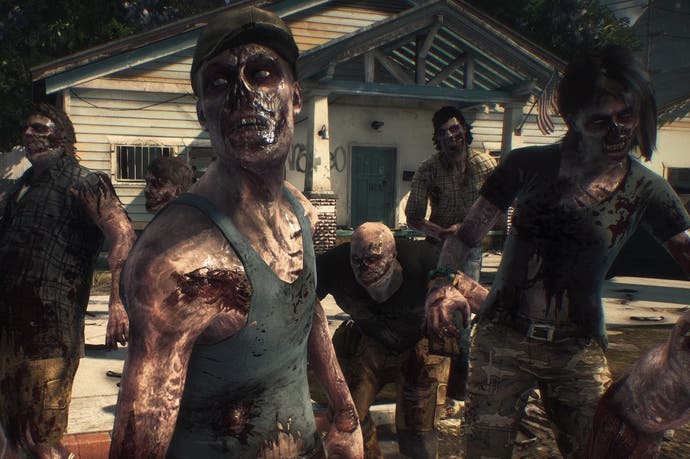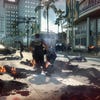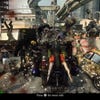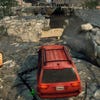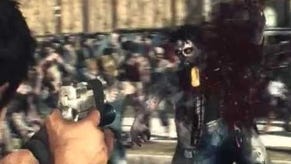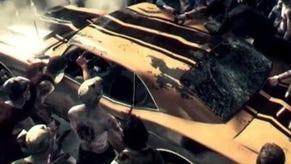Digital Foundry vs. Dead Rising 3
Dead reckoning.
Confirmed with surprising openness to be running at a straight 720p resolution at 30fps, Dead Rising 3 has much to prove to early Xbox One buyers. While many will be looking for evidence of a generational shift in terms of graphics and performance - ideally both - it's clear that development of this game has perhaps not been been as smooth as Capcom Vancouver would have preferred, appearing as it did with copious pop-in, tearing and serious frame-rate issues at Microsoft's 2013 E3 booth. But, raising its head once again at a London event, we're given an unfiltered hands-on with the title to see whether the extra months of development have given it a much-needed turnaround.
Right off the bat, the Vancouver studio (née Blue Castle) states it has ideas outside of resolution and frame-rate bumps to distinguish Dead Rising 3 from its current-gen efforts. Firstly, we have a full city to explore with no loading screens to interrupt the action. This pushes the segmented mall and town areas of the previous two games aside to facilitate a more sandbox-centric design, with the in-house engine able to stream the skyscrapers and bridges of Los Perdidos quickly enough to cope with the inclusion of speedy vehicles - widely available to cover this ground quickly. Transitions from indoors to out are, as promised, kept seamless in nature too.
Secondly, in keeping with the mantra of the E3 build, the zombie count is approximately triple that of Dead Rising 2's, opening up potential for ludicrous bouts of carnage when pile-driving through a sea of undead. But even with these added strains on the hardware, thankfully the screen-tear originally seen in a behind-doors session at E3 is now eliminated, giving us a perfectly integral image (though we do note that the version we saw had debug options allowing the developer to turn v-sync on or off). Whether it's during gameplay or cut-scenes, Dead Rising 3 is a more cinematic game for engaging v-sync, something you can see for yourself in our full playthrough of the fifth single-player chapter in the video below.
"Dead Rising 3's big problem is that despite its many next-gen enhancements, overall polish feels lacking, while resolution and frame-rate fall more into line with a current-gen title."
Undeniable advances these may be, we can't shrug off the feeling that other facets of the game's visual design suffer in the bid to achieve these bullet-points. Double-checking the native resolution, the game is indeed running at a fixed 1280x720 resolution as stated, with what appears to be the hallmarks of post-processing anti-aliasing. On the face of it, the limited pixel count gives Dead Rising 3 the familiar jagged look of almost any current-gen title you'd care to mention, not helped by the studio's decision to push for broader draw distances where distant details are obfuscated by the lower-resolution window.
Our captures show the game upscaled to 1080p by the Xbox One - with results that are expectedly unkind to thin objects and flickering alpha elements like trees or fence-work. It's a bit of a disappointment in this sense, and continues to dangle a question mark over the capabilities of the console's hotly contested specs when it comes to titles striving for full HD.
Accepting that some compromises go with the territory of developing a launch title, the question remains: has this technical trade-off been well-judged? Certainly, the zombie horde looks impressive in its increased numbers, and the boost here means the game's core appeal - the flourishes of fantastical violence - are ratcheted up another notch. The pop-in has also thankfully been reduced since the game's E3 appearance, though textures still visibly stream in after covering ground too quickly in vehicles. Object pop-in is mitigated through the use of a somewhat curious non-alpha fade-in technique, a visual quirk that has the polygonal structure of items like cones and fences fill out as our protagonist Nick Ramos walks forward. This gives a fizzling effect to weapons and vehicles too as they're summoned into the game world via the crafting system.
"Accepting that some compromises go with the territory of developing a console launch title, the question remains: has this technical trade-off been well-judged?"
With firework-brandishing forklifts possible with the right vehicle blueprint, the scope for effects-work in Dead Rising 3 is huge. There's no let-up in the ambition here: we have per-object motion blur, lens flares, and what appears to be full resolution fire alpha effects spurting from our first creation - a steamroller-motorbike hybrid. Explosions and smoke effects are a mixed bag, however. Some appear crisp and defined, but ploughing through a busy zombie crowds brings out distinctly blocky, sub-HD alpha that doesn't sit well with our image of next-gen gaming. These are likely a necessity given the volume of the effects needed when all fire off at once - a huge demand for any platform when running over hundreds of enemies in one go.
Elsewhere, the game's Havok physics engine remains the bedrock of Dead Rising's appeal when dealing with swarms of undead enemies. The AI is most suitably dumb, but each enemy is wont to slow your car's momentum as you drive through a crowd at low speeds, some flying off your bumper on impact, others dangling single-handed from the bonnet. These ragdoll physics also make sure that once they're dislodged they go flying off in style, and that major scenery like scaffolding and wired fencing falls apart as you blitz through. It's only a shame that it's not always clear which objects adhere to this engine's rules, meaning it can take some initial experimentation to understand the limits of the carnage.
Inevitably, much of this comes at a price; specifically to the frame-rate. When dealing with the signature scenes involving uncountable enemies on-screen, we're left with some very sluggish motion, while the streaming system also seems to spike CPU, resulting in lost performance. The statement from the team is that a locked 30fps is targeted here, but in the build we saw there's a huge gap to be bridged in this regard; drops to 20fps are consistent and sustained when outdoors, with 16fps being our record low during some of the biggest explosions. With Battlefield 4 on Xbox One, the drop to 720p opened the door to 60fps gameplay - Dead Rising 3's big issue is that despite the upgrades, the feeling in terms of refresh and response often feels very much like a poorly optimised current-gen title.
"With all its rough edges, Dead Rising 3's intended impact as a next-gen title is clearly dulled, but there's enough here to show a side of the zombie-slaying experience that couldn't be achieved on current-gen console hardware."
The day-lit fifth chapter proves slightly smoother in the frame-rate stakes, mainly due to it funnelling us through a few more interior areas to push the story along. Boss fights and side-missions here tend to be much less of a strain for the hardware, but once again, exiting a building to be met with an undead parade still gives us that unwanted drop to 20fps. With tearing absent from the majority of Xbox One launch titles, we're left to wonder how performance may have benefited here from having even an adaptive v-sync in place - though on balance the removal of tearing altogether on the build we saw is a warmly welcomed choice.
With all its rough edges, Dead Rising 3's intended impact as a next-gen title is clearly dulled, but there's enough here to show early Xbox One adopters a side of the zombie-slaying experience that couldn't be achieved on current-gen hardware. The zombie count and overall world size are impressive - amplified to a previously unheard volume where interplay with vehicles ties in appropriately with this shift in scale. However, the fact remains that the game's original brief as an Xbox 360 title is still very much felt in other areas; the pared-back alpha, texture streaming issues and jagged 720p presentation giving the impression that the series' potential is still somehow being bounded.
It's also unfortunate that the game runs at far from the promised locked 30fps - rather a chugging 20fps during the zombie action while out in the big city. Compared to the shaky E3 build seen just months ago this is still a respectable step forward, and of course many of the game's technical shortcomings come with the unique circumstances of meeting a hardware launch. All this amounts to an intriguing first attempt, then, but needless to say we're eager to see how Capcom Vancouver follows up on its sandbox survival-horror formula when it's given more breathing room with the deadline, more experience with the hardware, and factoring in the next-gen platform's strengths from the very start.
